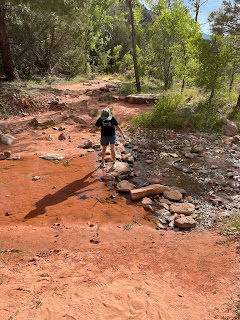Zion Park - Sunday, July 2
Kolob Canyon
We decided to eat lunch and relax before our next trail. In Hurricane (Herr-ih-ken) we made an effort to stay out of the sun. We cooked downstairs in the kitchen of our bed-and-breakfast. During my break, I wrote down notes about our hiking experiences.
In the late afternoon, we geared up to see the unpopular part of Zion. That's the northern third. There, the park allows visitors to drive themselves all the way to the trailheads. It should be the most popular section but the scenery isn't as iconic, I guess. During our trip, we asked at the two most popular parks why the rangers felt they were so popular. They replied, almost immediately, 'Instagram.' Particular trails look fantastic. As a consequence, people love to have their pictures taken while walking on them.
I don't know if the rangers were right. The most popular sites might be the best liked ones in every generation. It's clear what the rangers thought, though.
"Let's look at Kolob Canyon," Diane decided. She remembered what a ranger had told us about the stargazing from there. Due to the elevation and the isolation of the trailhead, the parking lot at Kolob Canyon was ideal to see stars at night.
Naturally, the first notice we saw on our arrival was a warning about cougars spotted in the area. The advice emphasized how guests should remain vigilant or, preferably, absent at night.
"I think I'll want a walking stick tomorrow morning," I remarked.
Diane didn't entirely roll her eyes, a sign she took the warning seriously, too.
"Okay," she said as she got out. "Let's go partway in. I want to see what it's like before we hike it in the dark."
"Ugh." I still had the cougars in mind.
"We won't hike it to the end," Diane emphasized. "We'll just go look."
Spoiler alert: this is not how it worked.
At first, we entered a broad trail wide enough for three or four hikers. It turned a corner and headed down rocky stairs and, very soon, just rocks. As deeply as we descended, we ascended soon after on a winding path. And that is how the trail proceeded for a while, up down and around on a narrow dirt path that turned into a wooded lane.
The terrain felt interesting and the heat of the late afternoon sun didn't bother us under the cover of the trees. After a while, our path led us into a stream. There were stepping stones laid in the water and it was fun to cross.
After a little while longer on the trail, Diane added, "I feel pretty good. Let's keep going."
A quarter of a mile later, we crossed the stream again. This time, our path lacked some of the stepping stones that would have made it easier. I looked around and found a broad, flat one to use. After I placed it, Diane tried it and pronounced it good.
In maybe an eighth of a mile, we crossed the stream again, our shoes mostly dry thanks to boulders and flat stones, which lay flat and brown above the water. We started to wonder how often we were going to do this. Not much later, we turned east and hiked along a sandy ridge beside the stream. And we crossed again. Eventually, we made five crossings. I added more large slabs to give us the capability to stay dry, night or day.
We made the crossings as easy as we could. If we were going to do this by moonlight, I was sure we wanted the stones to be as wide, flat, and as stable as possible. An hour or so into our march, we still hadn't reached the end of the trail.
"I think we've got to head back," I said, expecting an argument.
"That's fine," said Diane. She surveyed the green boughs over the trail ahead for a moment. More or less an instant after her pause, however, she turned around. "We'll be back."
In fact, we weren't. On the hike back, we continued to adjust and test the fordings. We left them in fine shape. When we got up the next morning at 4:00 a.m., though, the moon shone high overhead.
"We're cutting it close," Diane muttered as we packed into the rental car.
What she meant is the moon didn't look close enough to the horizon. It wasn't. We drove back to Kolob Canyon. Our car was alone in the parking lot. We got out to check for the best stargazing. But there was none. The brightness of the moon blocked out all but the brightest landmarks in the sky. With a stargazing app on my phone, I located Jupiter. But even Saturn was too dull or too low in the sky to spot.
Eventually, the moon set and the sun rose at the same time. It never grew dark enough to see the Milky Way. No constellations shone bright enough to see.




No comments:
Post a Comment